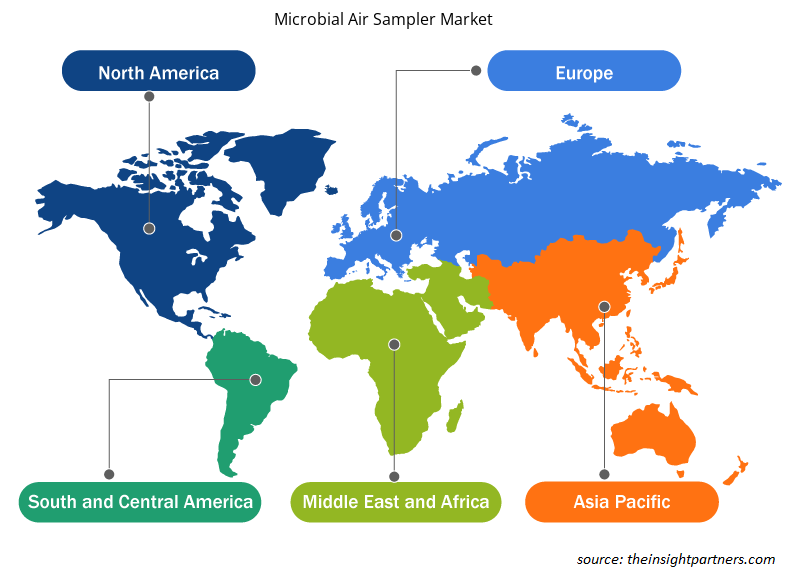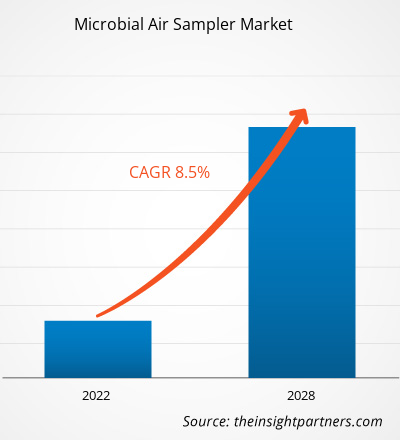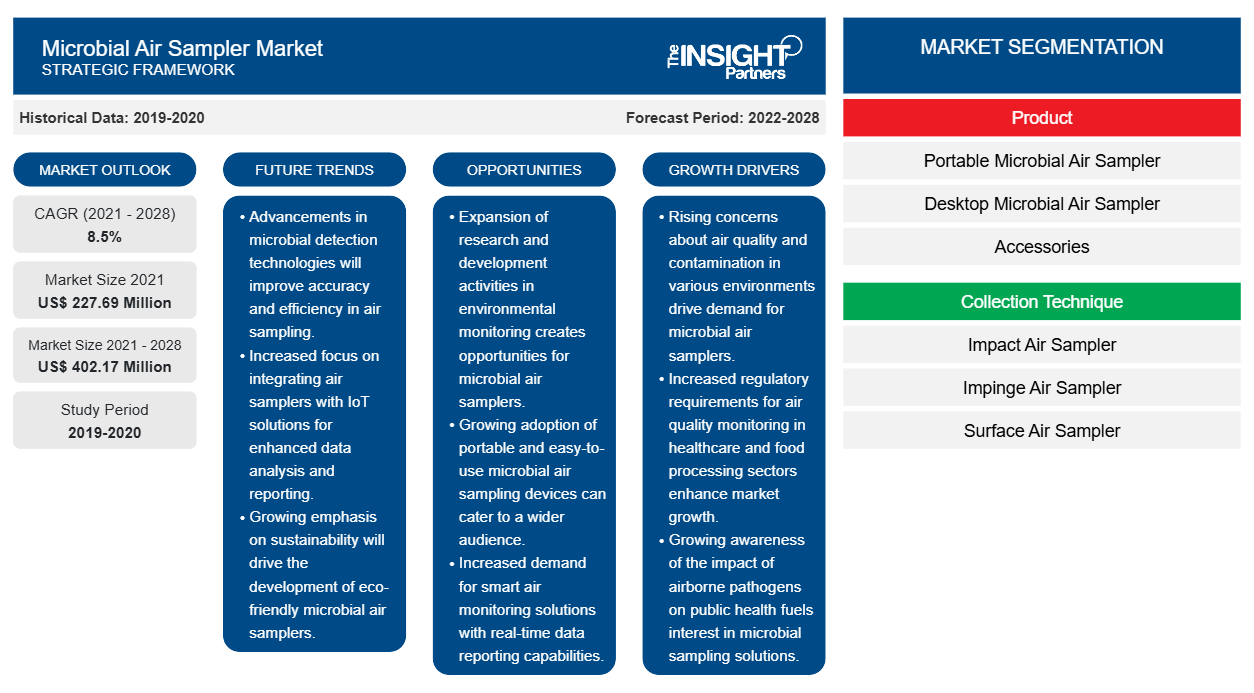Der Markt für mikrobielle Luftprobenehmer wird voraussichtlich wachsen von227,69 Millionen US-Dollar im Jahr 2021 auf 402,17 Millionen US-Dollar im Jahr 2028; es wird geschätzt, dass von 2021 bis 2028 eine durchschnittliche jährliche Wachstumsrate (CAGR) von 8,5 % verzeichnet wird.
Ein mikrobieller Luftprobenehmer ist ein Gerät zur Untersuchung mikrobiologischer Partikel in der Luft oder in einer kontrollierten Umgebung. Ein mikrobieller Luftprobenehmer funktioniert, indem er für einen bestimmten Zeitraum Luft in oder auf ein Sammelmedium presst. Die erhaltene Kultur wird dann inkubiert und das Vorhandensein der Mikroben in der Luft wird qualitativ und quantitativ bewertet. Er kann zur mikrobiologischen Luftuntersuchung bei Inspektionen auf mikrobiologische Kontamination in Reinräumen und hygienisch sensiblen Produktionsbereichen sowie an verschiedenen Geräten in der Lebensmittelindustrie verwendet werden.
Das Wachstum des Marktes für mikrobielle Luftprobenentnahmegeräte ist hauptsächlich zurückzuführen aufauf Faktoren wie den zunehmenden Einsatz mikrobieller Luftprobenehmer im Kampf gegen COVID-19 und die zunehmende Zahl mikrobieller Lebensmittelkontaminationen zurückzuführen.Bedenken hinsichtlich hoher Kapitalinvestitionen für die Einrichtung fortschrittlicher Labore hemmen jedoch das Marktwachstum.
Passen Sie diesen Bericht Ihren Anforderungen an
Sie erhalten kostenlose Anpassungen an jedem Bericht, einschließlich Teilen dieses Berichts oder einer Analyse auf Länderebene, eines Excel-Datenpakets sowie tolle Angebote und Rabatte für Start-ups und Universitäten.
-
Holen Sie sich die wichtigsten Markttrends aus diesem Bericht.Dieses KOSTENLOSE Beispiel umfasst eine Datenanalyse von Markttrends bis hin zu Schätzungen und Prognosen.
Markteinblicke
Zunahme der industriellen Aktivitäten in den Schwellenmärkten
Der Anstieg der Industrialisierung in Regionen wie dem Asien-Pazifik-Raum, Lateinamerika und Afrika hat das Bewusstsein der Menschen für Umweltverschmutzung und -zerstörung geschärft. Wirtschaftliche Aktivitäten haben das Potenzial, die Umweltqualität zu verbessern oder zu verschlechtern, was wirtschaftliche Aktivitäten fördern oder behindern kann. Luftverschmutzung ist für schätzungsweise 4,2 Millionen Todesfälle pro Jahr aufgrund von Schlaganfällen, Herzerkrankungen, Lungenkrebs sowie akuten und chronischen Atemwegserkrankungen verantwortlich. Ungefähr 91 % der Weltbevölkerung leben in Gebieten, in denen die Luftqualität den Richtwert der Weltgesundheitsorganisation (WHO) für Schadstoffwerte überschreitet. Infolgedessen wurden zahlreiche Umweltschutzgesetze erlassen, die dem Markt für mikrobielle Luftprobenehmer erhebliche Chancen bieten. Schwellenländer glauben, dass strenge Umweltgesetze ihre „verschmutzungsintensiven“ Industrien negativ beeinflussen werden. Darüber hinaus sind die Umweltvorschriften in Industrieländern immer strenger als in Entwicklungsländern. In den nächsten fünf Jahren werden wahrscheinlich verschiedene Änderungen und neue Umweltschutzstandards umgesetzt, vor allem in Entwicklungsländern in Regionen wie dem Asien-Pazifik-Raum aufgrund zunehmender Verschmutzung und Umweltverschmutzung. Die ständige Entwicklung innovativer Testmethoden für Schadstoffproben wie Pestizidrückstände, Schwermetalle und organische Verbindungen dürfte erheblich zum Wachstum des Marktes beitragen. Im März 2021 brachte Bertin Technologies Coriolis-Luftprobenehmer auf den Markt, um SARS-CoV-2, das für COVID-19 verantwortlich ist, zu sammeln und das Risiko einer Aerosolkontamination in kritischen Bereichen zu bewerten. Im Mai 2021 kündigte Aerosol Devices Inc die Veröffentlichung des neuen BioSpot-GEM-Probenehmers an, der speziell für den Einsatz im Feld entwickelt wurde, wo ein einfach zu verwendender Virenprobenehmer (auch für andere biologische Partikel) erforderlich ist. Die WHO entwickelt ein Clean Household Energy Solutions Toolkit (CHEST) zur Überwachung und Bewertung von Materialien, um die Luftverschmutzung in Haushalten zu bekämpfen.
Produktbasierte Einblicke
Der Markt für mikrobielle Luftprobenehmer ist nach Produkten in tragbare mikrobielle Luftprobenehmer, mikrobielle Luftprobenehmer für den Schreibtisch und Zubehör unterteilt. Das Segment der tragbaren mikrobiellen Luftprobenehmer hatte 2021 den größten Marktanteil und wird im Prognosezeitraum voraussichtlich die höchste durchschnittliche jährliche Wachstumsrate verzeichnen.
Erkenntnisse aus der Sammlungstechnik
Nach der Sammeltechnik ist der Markt für mikrobielle Luftprobenehmer segmentiert in Aufprall-Luftprobenehmer, Aufprall-Luftprobenehmer, Oberflächen-Luftprobenehmer, Druckluftprobenehmer, Echtzeitprobenehmer und andere. Im Jahr 2021 dürfte das Segment der Aufprall-Luftprobenehmer den größten Marktanteil halten und in den kommenden Jahren voraussichtlich am schnellsten wachsen.
Endbenutzerbasierte Erkenntnisse
Basierend auf dem Endverbraucher ist der Markt für mikrobielle Luftprobenehmer segmentiert in Forschungs- und akademische Institute, Krankenhäuser und Kliniken, Pharma- und Biotechnologieunternehmen, Lebensmittel- und Getränkeindustrie, Körperpflegeindustrie und andere. Das Segment der Forschungs- und akademischen Institute dürfte 2021 den größten Marktanteil halten und im Prognosezeitraum voraussichtlich die höchste durchschnittliche jährliche Wachstumsrate verzeichnen.
Einblicke basierend auf Vertriebskanälen
Basierend auf dem Vertriebskanal ist der Markt für mikrobielle Luftprobenehmer in Direktausschreibungen, Einzelhandelsverkäufe, Drittanbieter und andere unterteilt. Das Segment der Direktausschreibungen dürfte 2021 den größten Marktanteil halten und im Prognosezeitraum voraussichtlich die höchste durchschnittliche jährliche Wachstumsrate verzeichnen.
Produkteinführungen und Zulassungen sind häufig von Unternehmen angewandte Strategien, um ihre globale Präsenz und ihr Produktportfolio zu erweitern. Darüber hinaus konzentrieren sich die Akteure auf dem Markt für mikrobielle Luftprobenehmer auf die Partnerschaftsstrategie, um ihren Kundenstamm zu vergrößern, was ihnen wiederum ermöglicht, ihren Markennamen weltweit aufrechtzuerhalten.
Regionale Einblicke in den Markt für mikrobielle Luftprobenehmer
Die regionalen Trends und Faktoren, die den Markt für mikrobielle Luftprobenehmer im gesamten Prognosezeitraum beeinflussen, wurden von den Analysten von Insight Partners ausführlich erläutert. In diesem Abschnitt werden auch die Marktsegmente und die Geografie für mikrobielle Luftprobenehmer in Nordamerika, Europa, im asiatisch-pazifischen Raum, im Nahen Osten und Afrika sowie in Süd- und Mittelamerika erörtert.

- Erhalten Sie regionale Daten zum Markt für mikrobielle Luftprobenehmer
Umfang des Marktberichts über mikrobielle Luftprobenehmer
| Berichtsattribut | Details |
|---|---|
| Marktgröße im Jahr 2021 | 227,69 Millionen US-Dollar |
| Marktgröße bis 2028 | 402,17 Millionen US-Dollar |
| Globale CAGR (2021 - 2028) | 8,5 % |
| Historische Daten | 2019-2020 |
| Prognosezeitraum | 2022–2028 |
| Abgedeckte Segmente |
Nach Produkt
|
| Abgedeckte Regionen und Länder |
Nordamerika
|
| Marktführer und wichtige Unternehmensprofile |
|
Dichte der Marktteilnehmer für mikrobielle Luftprobenehmer: Die Auswirkungen auf die Geschäftsdynamik verstehen
Der Markt für mikrobielle Luftprobenehmer wächst rasant, angetrieben durch die steigende Nachfrage der Endnutzer aufgrund von Faktoren wie sich entwickelnden Verbraucherpräferenzen, technologischen Fortschritten und einem größeren Bewusstsein für die Vorteile des Produkts. Mit steigender Nachfrage erweitern Unternehmen ihr Angebot, entwickeln Innovationen, um die Bedürfnisse der Verbraucher zu erfüllen, und nutzen neue Trends, was das Marktwachstum weiter ankurbelt.
Die Marktteilnehmerdichte bezieht sich auf die Verteilung der Firmen oder Unternehmen, die in einem bestimmten Markt oder einer bestimmten Branche tätig sind. Sie gibt an, wie viele Wettbewerber (Marktteilnehmer) in einem bestimmten Marktraum im Verhältnis zu seiner Größe oder seinem gesamten Marktwert präsent sind.
Die wichtigsten auf dem Markt für mikrobielle Luftprobenehmer tätigen Unternehmen sind:
- Aerosol Devices Inc
- ORUM INTERNATIONAL
- Aquaria Srl,
- Cantium Scientific Limited,
- Cherwell Laboratories,
Haftungsausschluss : Die oben aufgeführten Unternehmen sind nicht in einer bestimmten Reihenfolge aufgeführt.

- Überblick über die wichtigsten Akteure auf dem Markt für mikrobielle Luftprobenehmer
Der Bericht segmentiert den Markt für mikrobielle Luftprobenehmer wie folgt:
Markt für mikrobielle Luftprobenehmer – nach Produkt
Markt für mikrobielle Luftprobenehmer – nach Sammeltechnik
- Aufprall-Luftprobenehmer
- Prallluftprobenehmer
- Oberflächen-Luftprobenehmer
- Druckluftprobenehmer
- Echtzeit-Sampler
- Sonstiges
Markt für mikrobielle Luftprobenehmer – nach Endbenutzer
- Forschungs- und akademische Institute
- Krankenhäuser und Kliniken
- Pharma- und Biotechnologieunternehmen
- Nahrungsmittel und Getränke
- Körperpflegeindustrie
- Sonstiges
Markt für mikrobielle Luftprobenehmer – nach Vertriebskanal
- Direkte Ausschreibung
- Einzelhandelsumsätze
- Drittanbieter
- Sonstiges
Markt für mikrobielle Luftprobenehmer – nach Geografie
-
Nordamerika
- UNS
- Kanada
- Mexiko
-
Europa
- Vereinigtes Königreich
- Deutschland
- Frankreich
- Italien
- Spanien
- Restliches Europa
-
Asien-Pazifik
- China
- Japan
- Indien
- Australien
- Südkorea
- Restlicher Asien-Pazifik-Raum
-
Naher Osten und Afrika
- Vereinigte Arabische Emirate
- Saudi-Arabien
- Südafrika
- Restlicher Naher Osten und Afrika
-
Süd- und Mittelamerika
- Brasilien
- Argentinien
- Restliches Süd- und Mittelamerika
Firmenprofile
- Aerosol Devices Inc
- ORUM INTERNATIONAL
- Aquaria Srl,
- Cantium Scientific Limited,
- Cherwell Laboratories,
- Multitech Enviro Analytical LLP,
- Spectrex Corp
- Munro Instruments Limited
- MERCK KGaA,
- BioMerieux SA
- Historische Analyse (2 Jahre), Basisjahr, Prognose (7 Jahre) mit CAGR
- PEST- und SWOT-Analyse
- Marktgröße Wert/Volumen – Global, Regional, Land
- Branchen- und Wettbewerbslandschaft
- Excel-Datensatz
Aktuelle Berichte
Verwandte Berichte
Erfahrungsberichte
Grund zum Kauf
- Fundierte Entscheidungsfindung
- Marktdynamik verstehen
- Wettbewerbsanalyse
- Kundeneinblicke
- Marktprognosen
- Risikominimierung
- Strategische Planung
- Investitionsbegründung
- Identifizierung neuer Märkte
- Verbesserung von Marketingstrategien
- Steigerung der Betriebseffizienz
- Anpassung an regulatorische Trends























 Kostenlose Probe anfordern für - Markt für mikrobielle Luftprobenehmer
Kostenlose Probe anfordern für - Markt für mikrobielle Luftprobenehmer